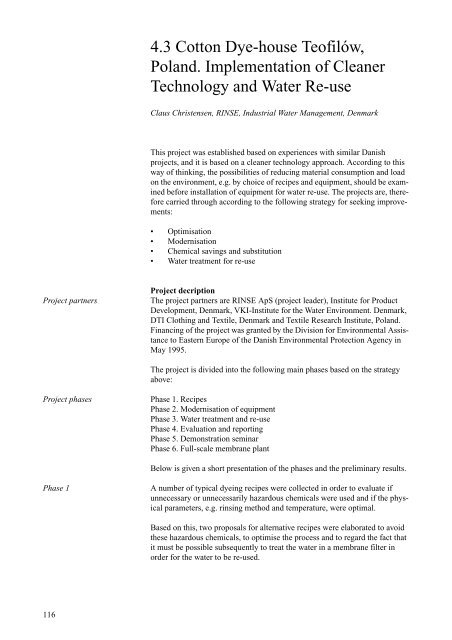Cleaner Technology Transfer to the Polish Textile ... - Miljøstyrelsen
Cleaner Technology Transfer to the Polish Textile ... - Miljøstyrelsen
Cleaner Technology Transfer to the Polish Textile ... - Miljøstyrelsen
You also want an ePaper? Increase the reach of your titles
YUMPU automatically turns print PDFs into web optimized ePapers that Google loves.
116<br />
4.3 Cot<strong>to</strong>n Dye-house Teofilów,<br />
Poland. Implementation of <strong>Cleaner</strong><br />
<strong>Technology</strong> and Water Re-use<br />
Claus Christensen, RINSE, Industrial Water Management, Denmark<br />
This project was established based on experiences with similar Danish<br />
projects, and it is based on a cleaner technology approach. According <strong>to</strong> this<br />
way of thinking, <strong>the</strong> possibilities of reducing material consumption and load<br />
on <strong>the</strong> environment, e.g. by choice of recipes and equipment, should be examined<br />
before installation of equipment for water re-use. The projects are, <strong>the</strong>refore<br />
carried through according <strong>to</strong> <strong>the</strong> following strategy for seeking improvements:<br />
• Optimisation<br />
• Modernisation<br />
• Chemical savings and substitution<br />
• Water treatment for re-use<br />
Project decription<br />
Project partners The project partners are RINSE ApS (project leader), Institute for Product<br />
Development, Denmark, VKI-Institute for <strong>the</strong> Water Environment. Denmark,<br />
DTI Clothing and <strong>Textile</strong>, Denmark and <strong>Textile</strong> Research Institute, Poland.<br />
Financing of <strong>the</strong> project was granted by <strong>the</strong> Division for Environmental Assistance<br />
<strong>to</strong> Eastern Europe of <strong>the</strong> Danish Environmental Protection Agency in<br />
May 1995.<br />
The project is divided in<strong>to</strong> <strong>the</strong> following main phases based on <strong>the</strong> strategy<br />
above:<br />
Project phases Phase 1. Recipes<br />
Phase 2. Modernisation of equipment<br />
Phase 3. Water treatment and re-use<br />
Phase 4. Evaluation and reporting<br />
Phase 5. Demonstration seminar<br />
Phase 6. Full-scale membrane plant<br />
Below is given a short presentation of <strong>the</strong> phases and <strong>the</strong> preliminary results.<br />
Phase 1 A number of typical dyeing recipes were collected in order <strong>to</strong> evaluate if<br />
unnecessary or unnecessarily hazardous chemicals were used and if <strong>the</strong> physical<br />
parameters, e.g. rinsing method and temperature, were optimal.<br />
Based on this, two proposals for alternative recipes were elaborated <strong>to</strong> avoid<br />
<strong>the</strong>se hazardous chemicals, <strong>to</strong> optimise <strong>the</strong> process and <strong>to</strong> regard <strong>the</strong> fact that<br />
it must be possible subsequently <strong>to</strong> treat <strong>the</strong> water in a membrane filter in<br />
order for <strong>the</strong> water <strong>to</strong> be re-used.

















